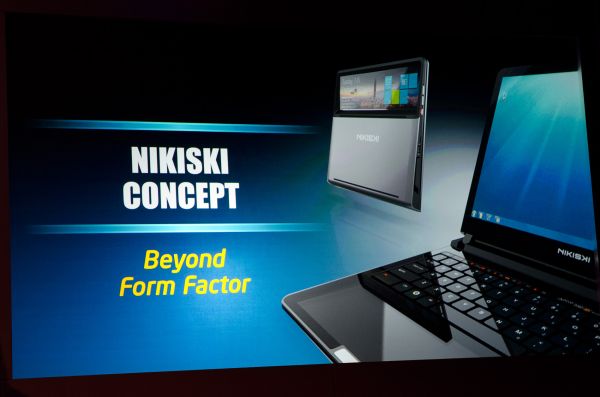Computex 2011: Intel Mentions Haswell Will Support "Multiple OSes", But Why?
by Anand Lal Shimpi on May 31, 2011 4:49 AM EST- Posted in
- Trade Shows
- CPUs
- Intel
- Haswell
- Computex 2011
I hate that I didn't pull my camera out quickly enough to catch this slide, but Intel's Mooly Eden just mentioned an interesting feature of Haswell. He stated that Haswell will support "multiple OSes". Clearly Sandy Bridge, Ivy Bridge and older Intel architectures have supported multiple OSes, but that was never listed as a feature until Haswell. I suppose this means more than it'll run both Windows and OS X, but what do you guys think Intel meant by it?
I already asked Intel and of course I didn't get an answer, I was just told that it was an astute observation and something we'll have to talk about at a later point in time. I suspect this is a statement about the future of the OS space in mobile computing but I'm not entirely sure what Intel views will be different come 2013. Microsoft will obviously support ARM in Windows 8, but what will Intel support with Haswell that it didn't before? What do you all think?
Mooly also showed off a concept Haswell PC called Nikiski. It's a notebook with a transparent touchpad area that lets you view part of your screen while the clamshell is closed. Check out pics of the concept in the gallery below.


















31 Comments
View All Comments
out_of_step - Tuesday, May 31, 2011 - link
Could be an embedded hypervisor.Don't know where the control domain would sit though ...
Or maybe iOS on Haswell?!?!
Targon - Tuesday, May 31, 2011 - link
If you look at the overall environment over the past few decades, the trend has been that hardware makers will support PC/Windows on one side, and then there has been a bit less support on the MacOS side. Linux has generally gotten support only from AMD/ATI for graphics drivers, and from NVIDIA.So, what if Intel has decided to try pushing optimizations for Intel processors and graphics on the Linux side of things for their new chips?
Chaki Shante - Tuesday, May 31, 2011 - link
Intel's still supporting/promoting MeeGo even though Nokia went away (and may be even more now that Nokia dropped).liveonc - Tuesday, May 31, 2011 - link
Will Intel enable emultation of ARM on their chips or is it possible to have both x86 & ARM switching between these like switching between IGP & discrete GPU? If switching between ARM & x86 is possible, will it run both ARM &x86 OS', or be able to run ARM & x86 OS' & ARM & x86 software while running on a different OS? If this is possible, will Windows 8 also sell OS's that run on both?StormyParis - Tuesday, May 31, 2011 - link
and are prissily striking back in their PR.The one success of Intel outside of Wintel is servers with Linux. Given the state of desktop Linux after years of trying, I wouldn't bet on it, aside from Android.
Rigan - Tuesday, May 31, 2011 - link
Android is my guess as to what they are talking about. There is no reason for them to worry with support for "arm compiled" software, nothing about the android could not be compiled and run on x86 hardware. We just learned a month ago that Google TV was always an android underneath, it's my bet that Chrom OS is also an android box, but just built on intel hardware. Give Google another year to pull the Chrom OS changes back into the core android platform and they will probably admit to this.About intel building an x86 that can pretend to be an arm, that is very hard to believe. I also don't see why they would bother. They have chips that can do nearly everything an arm can do, better. And they are clearly hot in the middle of making them small and power efficient enough to fit in the mobile market.
marraco - Tuesday, May 31, 2011 - link
It probably means some way of virtualization.AmdInside - Tuesday, May 31, 2011 - link
OS/2 is going to make a comeback? Perhaps BeOSFullHiSpeed - Tuesday, May 31, 2011 - link
nothing new - Marketing Hypefalacy - Monday, June 6, 2011 - link
Wouldn't it be interesting if Intel made a processor that is essentially an ARM processor with an x86 co-processor?The OS could run in the more efficient ARM code base and only utilize the x86 core when an application requests to run x86 code. You could then have a nifty dual core ARM processor to run your daily activities and when extra processing power is required, the OS and hardware are able to fire up the x86 cores and process that code seamlessly.
Seems weird, but I think it could work really well.